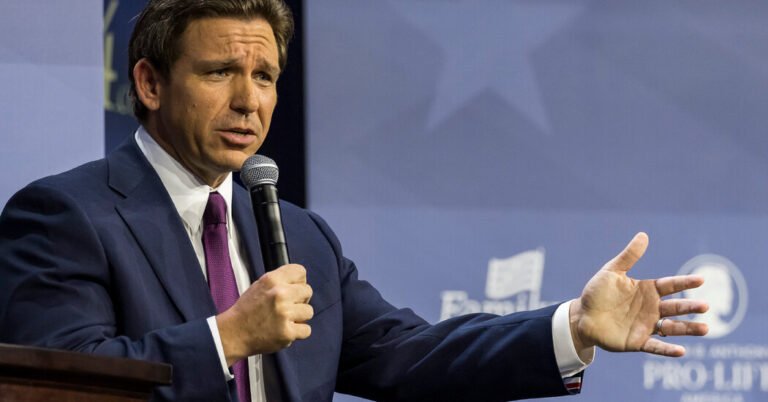As a fuller financial picture of the 2024 presidential race emerges with the campaign filing deadline on Saturday, trouble appears below the surface for Governor Ron DeSantis of Florida.
Despite a strong fund-raising total of $20 million, Mr. DeSantis spends handily, and his reliance on big donors suggests a lack of grassroots support. The campaign of former President Donald J. Trump recorded $17.7 million in fund-raising, almost all of which was transferred from another committee that will not report its donors until later this month.
Meanwhile, President Biden and the Democratic National Committee have raised almost as much money as all the Republican candidates for president.
Some of the more moderate Republicans – such as Nikki Haley, the former governor of South Carolina and ambassador to the United Nations – appear to have strong support and strong campaign operations built for long delivery. About a third of former Gov. Chris Christie’s $1.6 million haul in New Jersey came from small donors, which is high for Republicans and speaks to relatively broad appeal.
Warning signs are emerging for Republicans beyond Mr. DeSantis. Former Vice President Mike Pence brought in a meager $1.2 million contribution, raising questions about whether he could garner meaningful support among Republicans.
Then there are the self-funded candidates, whose campaigns last as long as they’re willing to spend their own fortunes — and for now at least, they sure are.
Here are some initial excerpts from the filings, which detail fund-raising and spending from April 1 to June 30.
DeSantis is banking on a lot of money … and he’s spending it fast.
In the six weeks between his entry into the race and the end of the quarter, Mr. DeSantis raised $19.7 million for his campaign, $16.9 million of which came from contributions of more than $200, a sign of his reliance on big-dollar contributions.
He spent that money too – quickly.
His filings on Saturday showed his campaign spent nearly $7.9 million in six weeks. Major expenses include $1.3 million earmarked for travel (several vendors seem to be private jet charter services); more than $1 million for payroll; and more than $800,000 each for digital fund-raising consulting, media placement and postage.
This is a “burn rate” of about 40 percent, which is on the high end compared to other Republican candidates. Senator Tim Scott of South Carolina reported raising nearly $5.9 million in the second quarter, and spending $6.7 million. But he has more than a cushion: He brought $22 million from his Senate campaign to his presidential run.
Reported by Mr. DeSantis had $12.2 million in cash on hand at the end of June; Mr. Scott has $21 million.
The full picture of Trump’s war chest is still unclear.
Mr. Trump is the runaway leader in the polls among Republican candidates, and he has considerable financial resources and fundraising ability. But his exact financial situation is complicated.
This month, Trump’s campaign said the former president raised more than $35 million in the second quarter through his joint fund-raising committee, which then transferred the money to his campaign and a political action committee.
His campaign filing Saturday reported a total of $17.7 million in receipts — which includes contributions, transfers and refunds — almost all transfers from the joint fundraising committee.
Where is the rest of the reported $35 million? The joint fund-raising committee does not have to file its report until the end of the month. The New York Times reported last month that Mr. Trump in recent months directed more money from the joint committee to the PAC, which he used to pay his legal fees.
Pence joined the stragglers.
Leading the Republican pack are former Arkansas Governor Asa Hutchinson, who raised about $500,000 in the second quarter, and Will Hurd, a former Texas congressman, who raised just $270,000.
While these long-shot candidates aren’t expected to raise tons of money, observers might expect more from former Vice President Mike Pence, who reported just $1.2 million in contributions.
Mr. Pence also spent very little – just $74,000, his filings show. His campaign has not said whether he has reached the threshold of 40,000 unique donors, one of the requirements to appear on the Republican debate stage on August 23.
Self-funded candidates are also burning through money.
Last Friday, the campaign of Gov. Doug Burgum of North Dakota, a wealthy former software engineer, submitted his quarterly report, showing that he raised $1.5 million in contributions and that he loaned $10 million to his campaign.
The campaign of Mr. Burgum spent more than $8.1 million last quarter, including an eye-popping $6 million on advertising, the filings show. He had $3.6 million in cash on hand at the end of the month.
Another Republican candidate, wealthy businessman Vivek Ramaswamy, reported $2.3 million in contributions last quarter, as well as $5 million in loans from himself. Mr. Ramaswamy has loaned his campaign $15.25 million since he entered the race in February; he said he would spend $100 million of his own money on his bid.
He might need it if he keeps spending. He spent more than $8 million from April to June, including $1.5 million in media placement and hundreds of thousands of dollars in travel.
